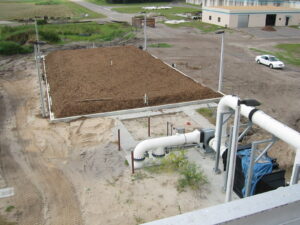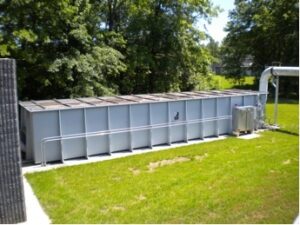The Advantages of Choosing a Biofiltration System for Odor Control
 More facilities are revisiting how they manage odor. Wastewater treatment plants, composting operations, and food processors all face pressure to reduce emissions. At the same time, many want to avoid chemical-heavy systems that come with added risks and maintenance demands. That’s where biofiltration comes in.
More facilities are revisiting how they manage odor. Wastewater treatment plants, composting operations, and food processors all face pressure to reduce emissions. At the same time, many want to avoid chemical-heavy systems that come with added risks and maintenance demands. That’s where biofiltration comes in.
A well-designed biofiltration system provides reliable odor control without relying on hazardous chemicals or complex equipment. At Webster Environmental Associates (WEA), we help facilities build and maintain systems that solve real problems, meet regulations, and fit into everyday operations.
Natural, Non-Chemical Treatment
One of the most important benefits of a biofiltration system is that it doesn’t require hazardous chemicals. Traditional chemical scrubbers rely on acid, caustic, or oxidizing agents to remove odors from air. These chemicals must be stored on-site, handled carefully, and monitored constantly. That adds cost, increases risk, and requires specific operator training.
Biofilters use naturally occurring microorganisms to treat odorous air. These microbes live in a moist bed of organic media—such as compost, bark, or engineered material—and break down odor compounds as air passes through. The process is simple, safe, and effective. There is no need for on-site chemical storage, and operators don’t need special training to handle dangerous substances. This makes biofiltration easier to manage day to day and lowers the risk of accidents.
Cost Savings Over Time
A biofiltration system usually has lower long-term operating costs than many chemical or mechanical alternatives. While the upfront installation may be similar to other systems, the savings come later. Biofilters use less electricity, especially when compared to systems that require large fans, chemical pumps, or control units. There are also fewer moving parts, so maintenance is simpler.
The media in a biofilter may last several years if managed well. During that time, facilities avoid the recurring costs of chemical purchases or replacement cartridges. In many cases, biofilters also require less downtime for maintenance, which helps keep operations moving. WEA designs biofiltration systems with real-world conditions in mind to keep performance strong while controlling long-term costs.
Strong Performance for Common Odors
Biofiltration is especially effective for the types of odors found at many industrial and municipal sites. These often include hydrogen sulfide, ammonia, and volatile organic compounds from organic waste. Biofilters are particularly well-suited for steady odor loads. If a site produces a fairly consistent volume and type of odor, the microbes in the system can adapt and perform well over time.
We’ve seen strong results at wastewater treatment plants, where biofilters are used at headworks, clarifiers, and sludge handling areas. Composting facilities rely on them to manage emissions from curing piles and enclosed process buildings. Food processors use biofiltration to handle odors from cooking, rendering, and waste handling areas. The system’s adaptability makes it a good fit across industries, especially for operations focused on predictable emissions and routine use.
Sustainability and Regulatory Benefits
 Biofiltration supports environmental goals in a way that many other technologies do not. Because biofilters use natural processes to remove odors, they don’t generate harmful waste or byproducts. That makes them a cleaner option, especially when compared to systems that require frequent chemical disposal or create large volumes of sludge.
Biofiltration supports environmental goals in a way that many other technologies do not. Because biofilters use natural processes to remove odors, they don’t generate harmful waste or byproducts. That makes them a cleaner option, especially when compared to systems that require frequent chemical disposal or create large volumes of sludge.
In some regions, the use of non-chemical odor control technologies can make it easier to meet permitting requirements. Regulators may favor systems that reduce chemical use and lower emissions. A biofilter can also support broader sustainability goals, including those related to carbon footprint and air quality improvements.
These systems also tend to be quieter and more visually unobtrusive than some other treatment options. This can help with community relations, especially for sites near neighborhoods or public areas. WEA works with clients to build systems that meet environmental targets while reducing the chance of complaints or regulatory concerns.
How WEA Builds Long-Lasting Biofiltration Systems
At Webster Environmental Associates, we design biofiltration systems to fit the specific needs of each site. We begin with testing to understand the types and levels of odor-causing compounds. Based on those results, we design the system layout, choose the right media, and size the unit for current and future airflow.
We don’t believe in one-size-fits-all systems. Some facilities need compact systems with minimal footprint. Others require large units to manage heavy emissions. Our team adjusts every design based on layout, operations, climate, and emission profiles.
We also provide full support after installation. That includes routine maintenance check-ins, media evaluations, and troubleshooting help. If conditions change at the site—such as higher loads or operational changes—we help adjust the system for continued performance.
Our goal is to make odor control easier, not harder. With the right design and support, biofiltration systems can run for years with consistent performance and lower operating costs.
Thinking About Switching to Biofiltration? Contact WEA
If you’re looking for an odor control option that’s safer, easier to run, and better for the environment, biofiltration is worth serious consideration. WEA has helped hundreds of facilities upgrade or switch to biofiltration systems that meet their goals and stay in compliance.
Whether you’re planning a new facility, replacing an outdated system, or responding to community concerns, we’re ready to help. Reach out to Webster Environmental Associates for a site evaluation or to discuss your options. We’ll help you figure out if a biofiltration system is the right fit—and if so, how to make it work for your site.
